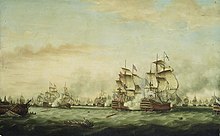Louis-Philippe de Vaudreuil
Louis-Philippe de Rigaud Marquis de Vaudreuil (born October 28, 1724 in Rochefort-sur-Mer or Québec , † December 14, 1802 ) was the second highest commanding officer of the French Navy during the American Revolutionary War .
family
Louis Philippe's father, Philippe de Rigaud de Vaudreuil , was born near Castelnaudary in 1663 ; His wife Soulange, who came from the Acadian peninsula , was the nurse of the sons of the Duke of Berry Charles Ferdinand de Bourbon in Versailles . His grandfather Pierre de Rigaud de Vaudreuil was the governor general of New France from 1703 to 1725, while his grandmother was close to Louis XIV .
There are some contradictions regarding the place of birth of Louis-Philippe de Vaudreuil. There are sources that see the place of birth in Québec . Others commit to Rochefort-sur-Mer . In fact, there is a portrait from that time on which his hometown is given as Rochefort. In addition, there is evidence that his father was in Rochefort on the French coast at the time in question. Since this port city was an important naval base at the time, historians consider Rochefort-sur-Mer the most likely place of birth.
Service in the French National Navy
Louis-Philippe de Rigaud de Vaudreuil entered the service of the French Navy when France sided with the Americans in 1778 and joined the American War of Independence . However, he fought his first battle in the sea battle off Ouessant on July 27, 1778.
Second Battle of the Cape off Yorktown 1781
In 1781 De Rigaud de Vaudreuil was on the French ship Le Scepter in the battle of Yorktown . After a brutal battle with ships of the British Royal Navy, the French fleet of Admiral François Joseph Paul de Grasse drifted away from the British and was thus out of sight. De Grasse decided, however, to sail back to Yorktown as soon as possible . He succeeded in doing this before the British adversaries, so that they refrained from further attacks and gave him control of the bay. The British troops on land were thus also included from the sea, so that the Commander-in-Chief General Charles Cornwallis, 1st Marquess Cornwallis, finally had to surrender. The Americans thus gained their independence with French and German help ( Royal Deux-Ponts ), which was manifested in the Peace of Paris . De Rigaud de Vaudreuil's contribution to the battle was to support the cavalry of the Duke of Lauzun Armand-Louis de Gontaut, duc de Biron . This cavalry was made up of soldiers from different nations (e.g. soldiers from Russia, Slavs, Poles, Germans) who were in French pay.
De Rigaud de Vaudreuil also made 800 men of his ship's crew available at Gloucester Point to defend the peninsula just outside Yorktown against attacks.
Together with the Duke of Lauzun, he fought and defeated the British troops of Banastre Tarleton , so that General Cornwallis could no longer get any help from him, which in turn accelerated his surrender.
Battle of Les Saintes 1782

In 1782 - France was still at war with the Kingdom of Great Britain - De Rigaud de Vaudreuil took part in the Battle of Les Saintes . His mission was to collect the French ships after the devastating defeat of the French and to save them from being hijacked or sunk. The fact that Admiral François Joseph Paul de Grasse was captured, he eventually rose to command the entire French fleet in America.
Defense of Boston 1782
After the battle of les Saintes, De Rigaud de Vaudreuil sailed on the Le Triomphant into the port of Boston and stayed there to defend the port against enemy attacks.
From here he ordered Jean-François de La Pérouse to attack British branches in Manitoba via the James Bay Passage. At the end of the war in 1783, De Rigaud de Vaudreuil was finally commissioned to transport the victorious armies of Jean-Baptiste-Donatien de Vimeur, comte de Rochambeau safely back to France after their expeditions.
Others
- The battle between the Duke of Lauzun and Banastre Tarleton at the de Rigaud de Vaudreuil took part in the movie was The Patriot ( The Patriot (film) ) with Mel Gibson filmed and particularly pointed out.
Web links
- Louis-Philippe de Rigaud de Vaudreuil at Yorktown
- The Washington Papers - Letters from Vaudreuil
- Carricature of Louis-Philippe de Vaudreuil - Caricature by Vaudreuil
| personal data | |
|---|---|
| SURNAME | Vaudreuil, Louis-Philippe de |
| ALTERNATIVE NAMES | Rigaud de Vaudreuil, Louis-Philippe de |
| BRIEF DESCRIPTION | French officer, second highest in command of the French Navy during the American Revolutionary War |
| DATE OF BIRTH | October 28, 1724 |
| PLACE OF BIRTH | Rochefort (Charente-Maritime) or Québec |
| DATE OF DEATH | December 14, 1802 |

